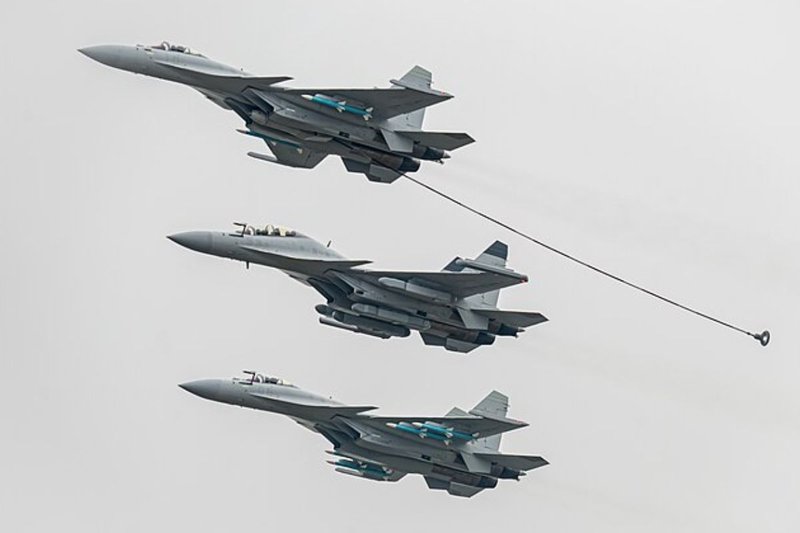Is Chinese naval air power ready for action?
The J-35A flying at Zhuhai Airshow in November 2024. (Photo: Wikimedia Commons/中国新闻社)
Much has been made of China’s ambitions to become a full-spectrum ‘blue water’ naval power, with a necessarily potent embarked aviation arm. With new information emerging about the People’s Liberation Army Navy (PLAN) aircraft carriers and the fast jets they will deploy, it is timely to examine what role these assets will play, and how Beijing intends to integrate them into the wider fleet.
Around three years ago, the first images appeared of what was thought to be the PLAN’s new fighter aircraft. This was a wholly indigenous design, initially given the designation FC-31.
At the Zhuhai Airshow in November 2024, a model of the aircraft bearing the designation J-35A was shown, suggesting this is the true nomenclature. Whether or not the PLAN’s variant is officially the ‘J-35C’ remains open to question.
Related Articles
In depth: US and China’s complex arms race over Taiwan
China unveils new military kit and demonstrates technological prowess
At the same time, a new version of the J-15 naval fighter emerged. Equivalent to the J-11D People’s Liberation Army Air Force (PLAAF) model, this fighter is a modified Sukhoi Su-30/33 platform with domestic systems and Chinese WS-10 engines. The PLAN has operated several confusingly designated models, including what was once thought to be the J-15B, followed by the J-15D, J-15S and possibly J-17.
Alongside these models are the PLAAF’s J-11 variants, plus the J-16 strike aircraft, which might also have an electronic-warfare (EW) focussed ‘D’ model. In conclusion, the later J-11s and J-16 appear to be new land-based platforms, while the J-15s will operate with the navy. The latest member of the latter family that appeared late this year is generally reckoned to be the J-15T, which is definitely a PLAN aircraft.
What do we know about the PLAN’s aircraft carriers?
At present the PLAN has only two aircraft active carriers, the Liaoning and Shandong. Based on the 1970s-era Soviet Kuznetsov class, these are conventionally powered and have a ‘ski-jump’ at the front to help aircraft gain altitude rapidly as they leave the deck. The carriers are simple but have variable efficiency. Colloquially, they are known as a short take-off but assisted recovery system or STOBAR (it uses classic arrestor wires at the rear of the deck to stop incoming aircraft).
Although the carrier’s forward motion is important, take offs depend almost wholly on the aircraft’s engine power and even with the brief boost from the bow ramp, there is simply a limit to the size and weight of what can be launched. This type of operation also precludes use of E-2-type turboprop aircraft seen on US Navy carriers, as these would not be viable with a bow ramp alone.
To correct this deficiency, a wholly new class of Chinese aircraft carrier has emerged. The first carrier, Fujian, is currently undergoing sea trials. At over 80,000 tonnes, it is closer to the size of US CVNs, although conventionally powered, and can handle larger aircraft types. It also features deck catapults that assist in accelerating aircraft up to flying speed and hence enable a successful departure even at nominal maximum weight.
This modern iteration of the catapult-assisted take-off but arrested recovery (CATOBAR) system means China has joined an exclusive club whose only other member is the US Navy. Furthermore, PLAN catapults will be electromagnetic (EMALS) versions that provide smoother acceleration and are a technology America has yet widely to deploy.
Returning to the aforementioned pair of new fighters, both the J-35 (C?) naval model and J-15T feature a reinforced nose landing gear with a catapult bar. This does not preclude their serving on the older vessels, albeit with some reduction in mission performance, but it shows that they are intended for the CATOBAR Fujian and its future sister ships.
To further boost the new PLAN carrier battle group, Fujian will embark the Xi’an KJ-600 airborne early warning (AEW) aircraft. Equivalent to the US E-2 Hawkeye, this will be a great additional benefit to the air wing. While the J-15Ts will act as a multi-role equivalent to the F/A-18E/F – and possibly with an EW capability that covers some of the EA-18 Growler mission set, the J-35 mirrors the F-35C strike aircraft. Considering all these types together, the PLAN has taken a significant step towards a USN-style capability, although obviously with a fraction of the actual carrier fleet size (for now).

Assessing the J-15T and the J-35
While new, there is not much to note about the J-15T. It has kept the overall outline of the Su-27 line and in this case is a single-seater. The radome design is slightly different and believed to contain a modern AESA radar. Onboard systems are likely new or updated and the engines will likely be some variant of the Chinese WS-10.
Conversion from mechanical controls to a fly-by-wire arrangement is also possible, enabling the aircraft to enter commanded manoeuvres rapidly and with better controllability. Although not for certain, some have also speculated that modern materials have been used on the airframe that might lower the radar cross-section (RCS).
By comparison, there is more interest in the J-35 and its naval incarnation. A smooth finish, supersonic divertless engine intakes as well as a common angle across wings, fuselage and tail are all to be seen in its low-RCS contemporaries, as is an internal weapons bay.
One feature of interest on the J-35 is the higher rear fuselage behind the forward-opening canopy. This could have two main goals. First, the airflow can form vortices and other drag-inducing effects if it detaches inefficiently from the rear of the canopy – a reason why designers often prefer embedded cockpits. Aircrew want a better view, so over time some compromise tends to be reached between the two parties.
The second is that a cockpit is a cluttered place, and the canopy cannot be shielded from enemy radar to the same extent as the rest of the airframe. Reducing its size and having more of the surround in opaque material makes a small but positive difference. There is, however, no evidence of the lift-fan that dictates the F-35B’s ‘hunchback’ form, so that seems an unlikely answer.
Both new aircraft are expected to use PL-10 short-range and PL-15 long-range air-to-air missiles. The latter was seen at Zhuhai with folding fins, allowing six to be carried within the larger J-20 fighter’s bay and perhaps four plus two PL-10s in the J-35. The J-15 would also be an obvious carrier for the larger PL-20 series of missiles that are expected to be used against AEW or tanker aircraft.
However, the J-20 is not intended (yet) for naval use. Moreover, PL-20 missiles would likely have an impact on the utility of a J-15 when operating from a carrier, given their weight, size and impact on fuel consumption and carriage.
The aircrafts’ capabilities are not insignificant
Crucially, the actual capabilities of these new aircraft and how they will be used remain largely unknown. Even where an opposing system has become familiar, there is still much that can be misinterpreted. Clearly, a fleet of two small and one medium aircraft carriers still leaves the PLAN trailing far behind the US, but these vessels are worthy of consideration for three reasons.
First, they show the intended path envisaged by PLAN commanders, which by association is supported by the Beijing government. Exact numbers as to how many aircraft will be built remains open, but to achieve any kind of Pacific or South China Sea power projection a minimum of four is probably needed.
The second point is that the decision to adopt EMALS catapults makes a statement about confidence in China’s ability develop new technology, both in testing and on board a carrier in a Pacific storm.
The third aspect is that the new ships will provide unmatched experience of larger-scale naval operations and the approach to tasks big and small, from doctrine to deck marshalling with catapults. The PLAN may conclude, for instance, that it needs a refuelling drone akin to a more basic MQ-25.
Assessed altogether while these elements will not upset the global balance of surface naval power, they are not inconsequential.
Set against a wider backdrop, China is churning out theoretical and actual designs of new naval vessels and its fleet is becoming more numerous and capable. Crucial to remember is that aircraft carriers do not operate in isolation, and one thing not covered in this article is the uncrewed element of PLAN aviation or wider combined arms. At least one ‘drone carrier’ is under construction, alongside new and powerful amphibious assault ships.
Add that to cruisers, destroyers, frigates, supply ships, specialist vessels and submarines, not to mention the infamous DF-21 anti-ship ballistic missiles, the current sea trials of Fujian start to take on more meaning.
Naturally, like with most intelligence work, the picture still remains an incomplete jigsaw – a picture you cannot see from inside the box. But looking at what the US, British, French, Japanese and South Korean navies are doing, similar thinking, goals and development are evident in China.
As China gradually adds pieces to the board and learns how to use them, the PLAN’s utility as a policy tool both grows and becomes more tempting to use. Surface fleets are deterrents as well as active combatants, and while the J-15T and J-35 are not decisive in themselves, but they represent another few steps along the way.
This analysis article originally appeared in November’s Decisive Edge Air Newsletter. To receive regular updates from Edward Hunt and our team of defence experts visit our Decisive Edge sign up page.
Related Equipment in Defence Insight
More from Air Warfare
-
![Boeing E-7A still in South Korean AEW&C competition, despite dropout reports]()
Boeing E-7A still in South Korean AEW&C competition, despite dropout reports
The E-7A is one of three aircraft submitted for the South Korean AEW&C II competition, which seeks to acquire four more aircraft of the type for its air force by 2028.
-
![France pushes for 80% workshare as FCAS programme nears critical development stage]()
France pushes for 80% workshare as FCAS programme nears critical development stage
Tensions on the programme have long simmered, with Airbus and Dassault recently clashing over workshare in June ahead of the Paris Air Show. The sixth-generation fighter programme is due to replace Rafale and Eurofighter Typhoon jets beginning in 2040.
-
![US Air Force conducts climate testing with the T-7A Red Hawk]()
US Air Force conducts climate testing with the T-7A Red Hawk
The trainer aircraft recently completed the second round of extreme weather trials after enduring icy, windy and sunny conditions.





















